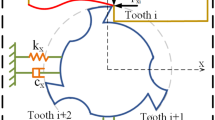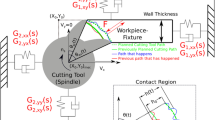Abstract
Milling force is one of the key output variables related to milling efficiency and accuracy. However, the time-consuming identification of milling forces cannot be evaluated online for machining performance during the milling process. In this paper, a novel millisecond-level method is developed to identify the milling forces online using acceleration signals. Firstly, the milling force identification problem is transformed into an ill-posed problem in the time-domain convolution framework. Next, the advantages of the regularization method for the ill-posed problem are analyzed. Then, the properties of the transfer matrix and the regularization operator are used to reduce the milling force identification time. Lastly, the proposed method is verified with several sets of milling experiments, and the results show that the accuracy of milling force identification is acceptable and the identification time is less than 10 ms.












Similar content being viewed by others
Availability of data and material
It can be obtained from the author by mail.
Code availability
Not applicable
References
Abele E, Altintas Y, Brecher C (2010) Machine tool spindle units. CIRP Annals - Manufacturing Technology. 59(2):781–802. https://doi.org/10.1016/j.cirp.2010.05.002
Cao HR, Zhang XW, Chen XF (2017) The concept and progress of intelligent spindles: A review. International Journal of Machine Tools and Manufacture. 112:21–52. https://doi.org/10.1016/j.ijmachtools.2016.10.005
Li DH, Cao HR, Chen XF (2022) Displacement difference feedback control of chatter in milling processes. The International Journal of Advanced Manufacturing Technology. 120:6053–6066. https://doi.org/10.1007/s00170-022-09128-w
Martella M, Rotating dynamometer. (Product News). (Kistler Instrument’s Type 9125), Sensors Magazine. (2002)
Li X, Djordjevich A, Venuvinod PK (2000) Current-sensor-based feed cutting force intelligent estimation and tool wear condition monitoring. IEEE Transactions on Industrial Electronics. 47(3):697–702. https://doi.org/10.1109/41.847910
Li X, Venuvinod PK, Chen MK (2000) Feed Cutting Force Estimation from the Current Measurement with Hybrid Learning, The International Journal of. Advanced Manufacturing. 16:859–862. https://doi.org/10.1007/s001700070002
Li XL, Li HX, Guan XP, Du R (2004) Fuzzy estimation of feed-cutting force from current measurement-a case study on intelligent tool wear condition monitoring, IEEE Transactions on Systems, Man, and Cybernetics. Part C (Applications and Reviews). 34(4):506–512. https://doi.org/10.1109/TSMCC.2004.829296
Jeong YH, Cho DW (2002) Estimating cutting force from rotating and stationary feed motor currents on a milling machine. International Journal of Machine Tools and Manufacture. 42(14):1559–1566. https://doi.org/10.1016/S0890-6955(02)00082-2
Altintas Y (1992) Prediction of cutting forces and tool breakage in milling from feed drive current measurements. Transactions of the ASME Journal of Engineering for Industry. 114(4):386–392. https://doi.org/10.1115/1.2900688
Aslan D, Altintas Y (2018) Prediction of cutting forces in five-axis milling using feed drive current measurements. IEEE/ASME Transactions on Mechatronics. 23(2):833–844. https://doi.org/10.1109/TMECH.2018.2804859
Kim D, Jeon D (2011) Fuzzy-logic control of cutting forces in CNC milling processes using motor currents as indirect force sensors. Precision Engineering. 35(1):143–152. https://doi.org/10.1016/j.precisioneng.2010.09.001
Zhu JM, Wang J, Zhang TC, Li XR, Dynamic milling force measuring method based on cutting tool vibration displacement, Chinese Journal of Scientific Instrument. 35(12) (2014) 2772–2782, https://doi.org/10.19650/j.cnki.cjsi.2014.12.016
Albrecht A, Park SS, Altintas Y, Pritschow G (2005) High frequency bandwidth cutting force measurement in milling using capacitance displacement sensors. International Journal of Machine Tools and Manufacture. 45(9):993–1008. https://doi.org/10.1016/j.ijmachtools.2004.11.028
Wan M, Yuan H, Feng J, Zhang WH, Yin W (2017) Industry-oriented method for measuring the cutting forces based on the deflections of tool shank. International Journal of Mechanical Sciences. 130:315–323. https://doi.org/10.1016/j.ijmecsci.2017.06.022
Gregory WV, Dominique AR, Feng J, Gregory MC (2022) Real-time estimation of cutting forces via physics-inspired data-driven model. CIRP Annals - Manufacturing Technology. 71:317–320. https://doi.org/10.1016/j.cirp.2022.04.071
Wang CX, Zhang XW, Qiao BJ, Chen XF, Cao HR (2018) Milling force identification from acceleration signals using regularization method based on TSVD in peripheral milling. Procedia CIRP. 77:18–21. https://doi.org/10.1016/j.procir.2018.08.195
Zhou J, Mao XY, Liu HQ, Li B, Peng YL (2018) Prediction of cutting force in milling process using vibration signals of machine tool. The International Journal of Advanced Manufacturing Technology. 99:965–984. https://doi.org/10.1007/s00170-018-2464-1
Salehi M, Albertelli P, Goletti M, Ripamonti F, Tomasini G, Monno M (2015) Indirect model based estimation of cutting force and tool tip vibrational behavior in milling machines by sensor fusion. Procedia CIRP. 33(1):239–244. https://doi.org/10.1016/j.procir.2015.06.043
Mostaghimi H, Park CI, Kang G, Park CC, Dong YL (2021) Reconstruction of cutting forces through fusion of accelerometer and spindle current signals. Journal of Manufacturing Processes. 68:990–1003. https://doi.org/10.1016/j.jmapro.2021.06.007
Wang CX, Zhang XW, Qiao BJ, Chen XF (2019) Dynamic force identification in peripheral milling based on CGLS using filtered acceleration signals and averaged transfer functions. Journal of Manufacturing Science and Engineering. 141(6):1–8. https://doi.org/10.1115/1.4043362
Wan M, Yin W, Zhang WH, Liu H (2017) Improved inverse filter for the correction of distorted measured cutting forces. International Journal of Mechanical Sciences. 120:276–285. https://doi.org/10.1016/j.ijmecsci.2016.11.033
Golub GH, Reinsch C (1970) Singular value decomposition and least squares solutions. Numerische Mathematik. 14:403–420. https://doi.org/10.1007/BF02163027
Bishop CM (1995) Training with Noise is Equivalent to Tikhonov Regularization. Neural Computation. 7(1):108–116. https://doi.org/10.1162/neco.1995.7.1.108
Roozbeh M, Arashi M, Hamzah NA (2020) Generalized Cross-Validation for Simultaneous Optimization of Tuning Parameters in Ridge Regression, Iranian Journal of Science and Technology, Transactions A. Science. 44:473–485. https://doi.org/10.1007/s40995-020-00851-1
Akgun MA, Garcelon JH, Haftka TR (2001) Fast exact linear and non-linear structural reanalysis and the Sherman-Morrison-Woodbury formulas. International Journal for Numerical Methods in Engineering. 50(7):1587–1606. https://doi.org/10.1002/nme.87
Böttcher A, Silbermann B (1999) Introduction to Large Truncated Toeplitz Matrices, Springer. New York. https://doi.org/10.1007/978-1-4612-1426-7
Funding
This work is supported by the National Natural Science Foundation of China (No. 51922084).
Author information
Authors and Affiliations
Contributions
Qi Li: resources, methodology, software. Maxiao Hou: conceptualization, writing — original draft, software. Hongrui Cao: conceptualization, writing — review and editing, supervision, project administration, funding acquisition.
Corresponding author
Ethics declarations
Ethics approval
Not applicable
Consent to participate
Not applicable
Consent for publication
Not applicable
Conflict of interest
The authors declare no competing interests.
Additional information
Publisher's Note
Springer Nature remains neutral with regard to jurisdictional claims in published maps and institutional affiliations.
Rights and permissions
Springer Nature or its licensor (e.g. a society or other partner) holds exclusive rights to this article under a publishing agreement with the author(s) or other rightsholder(s); author self-archiving of the accepted manuscript version of this article is solely governed by the terms of such publishing agreement and applicable law.
About this article
Cite this article
Li, Q., Hou, M. & Cao, H. Online identification of milling forces using acceleration signals. Int J Adv Manuf Technol 127, 4491–4501 (2023). https://doi.org/10.1007/s00170-023-11645-1
Received:
Accepted:
Published:
Issue Date:
DOI: https://doi.org/10.1007/s00170-023-11645-1




